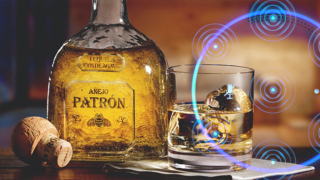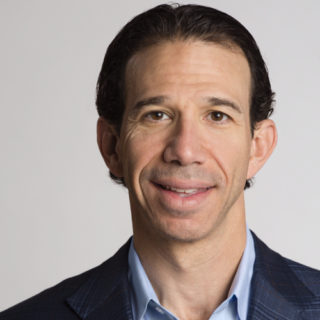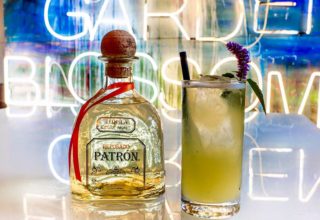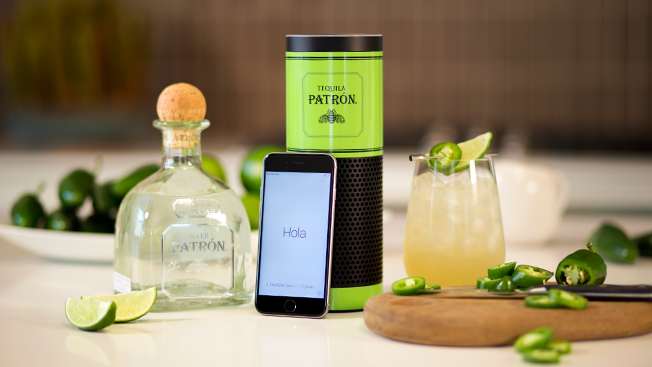Stay-at-home bartenders and conquistadors of the cocktail, rejoice, because consuming tequila and making craft drinks is a whole lot cooler and digital now thanks to the creation of the Patrón Cocktail Lab.
The tequila maker has paired with Amazon’s smart speaker Echo to deliver over 150 cocktail recipes, as well as recommendations and tips ranging from perfect pairings for food to proper ways to shake and strain Mexico’s favorite spirit. Think of it as a tequila-specific robotic sommelier who mixes more than just a margarita through the Alexa app on Amazon Alexa and Amazon Echo.
In addition to housing recipes in an interactive cocktail recommendation site, Patrón is pioneering voice-enabled devices technology by becoming the first luxury spirit brand on the Amazon Alexa platform.
Lee Applbaum, Patrón’s global chief marketing officer, joined [a]listdaily to discuss how the tequila brand is becoming a digital tastemaker in a variety of platforms including social media and virtual reality.

Why was the Patrón Cocktail Lab a smart next step for the company?
First let me set up some context for what we’re doing—we’re not a technology company. So this isn’t an endemic move; this is a means-to-an-end move. We’re very fortunate at Patrón because we have exceptional brand equity, really high brand awareness, a brand with a lot of caché and swagger. As a marketing organization, we’ve been spending a lot of our time to better tell authentic stories. We developed the Cocktail Lab as a very consumer-centric view of accessing different recipes, and voice had to be an important part of it. Echo and Alexa became an immediate way to showcase our interest in voice-driven engagement, but by no means is this the end of the story.
Why was Amazon Echo the perfect partner for this activation? What does their platform allow you to accomplish that others don’t?
I think Amazon has done a very nice job to quickly create an easy-to-use product for consumers. It’s a seamless process to engage with Alexa. The hardware is industry leading and the interface is simple. Amazon is so ubiquitous that I think they’ve gotten a lot of traction quickly. For us, it was a no-brainer in terms of our first foray into this platform. In terms of scale, obviously iOS and Siri have nearly 50 percent operating system share of market. Siri makes a lot of sense as well. By Apple’s own admission, there’s a lot of room for Siri to continue to enhance its functionality. We saw Amazon as a more mature platform to be able to jump into very quickly. There’s a lot of buzz around the platform right now. There’s that visible hardware component of Amazon Echo that we saw as an easy way for people to be able to engage with. Then there’s an entertaining side to Amazon Alexa. You’ve got this cool piece of hardware sitting on your desktop. For Patrón, it’s about useful engagement because we’re not trying to do this just for the entertainment aspect. We want it to be a fulfilling and educational, and ultimately, give consumers entertaining content. We’re a tequila brand, for goodness sake! We’re not solving the world’s problems.

Why did Patrón decide that using consumer-aimed voice recognition services like Alexa is crucial to growing the brand profile?
I think we want to cohabitate with consumers. By that I mean we want to present our brand story, describe product attributes, or in this case, better communicate versatility in a way in which consumers want to engage with us, rather than forcing them to do it the way we wanted to. For us it was just a logical decision to say, ‘this is how consumers are engaging with content and we want to do it in the most seamless way possible.’ The other thing is, for us, innovation is a very important part of our DNA. Twenty-seven years ago, we created the ultra-premium tequila category—we didn’t create tequila. Innovation in marketing and technology is just an extension. It showcases our interest and our commitment.
What’s the plan to track visitation, engagement and measure overall success for Patrón Cocktail Lab?
Analytics are better used to shape the experience. We like to look at everything from where consumers spend their time, how much time they’re spending, where they’re abandoning. We don’t have the shopping cart path-to-purchase metrics that Amazon has. There isn’t a commerce-engaged function. We do expect that to come eventually, where a consumer could identify the cocktail they want, and then conceivably through Amazon’s shopping platform, buy the cocktail ingredients. That doesn’t exist today, so for us it’s really about being able to better understand the consumer’s migration through the Cocktail Lab to enhance functionality and better deliver recipes and solutions. That’s obviously the beauty of the digital ecosystem. For us, Echo is really the first step. Our vision, if we take a step back, the richer the data that we can get, the better that we can be a part of creating memorable experiences for consumers. It’s not just about selling more tequila—it’s about hoping to make more memorable experiences. It’s a matter of aggregating the data and having the algorithms on the back end that allow us to think, the recommendation engine, about how do we take all these inputs and give you back useful cocktails that make sense for you.
The Patrón Cocktail Lab campaign is supported with social media, including Facebook and Twitter. Patrón is largely considered to be the top Tequila brand on social. How do you separate yourselves from other competitive brands with your social platforms?

We’re very fortunate that we have a brand that is loved. We have a near 70 percent market share of ultra-premium tequila in the US. If you look at our numbers, they’re near incomparable in terms of brand affinity, awareness and attention. Part of that is consumers love our brand. They love to talk about our brand, share stories with us—there’s an organic interest with Patrón. Social gives us a way to syndicate those moments. Our interaction is the ability to help curate and re-share those moments that consumers may post. It’s amazing . . . we were virtually uninvolved with social three years ago when I arrived at the company. We had no social practice. We weren’t even on Twitter or Instagram. We had a nascent presence on Facebook, yet consumers were already engaging with us. We had a relatively easy task in that our job was just to jump in to the conversation, help curate it, but not force it. That’s how we sort of went from zero to hero.
How will you be further marketing the Patrón Cocktail Lab moving forward?
This isn’t an above-the-line, traditional media play. We’re not selling Amazon Echoes. We’re really talking about this broader idea of the versatility of tequila and the way of accessing that content through Cocktail Lab and Alexa. We see it as a very organic conversation. However, we do have a significant amount of social and digital media behind this, which makes sense given that this is a digital product. Globally, we’re the largest spirit in social media. We’re No. 1 on Twitter, and a top-five beer, wine or spirit brand on Facebook and Instagram. We have nearly five million consumers across our social media channels, which is huge when you think about age-gating for consumers over 21—and they’re highly engaged. Social media is a big piece of the marketing. There’s an incredible interest in our brand, incredible interest in the ultra-premium category, so creating easy ways for consumers, and engaging ways for consumers to interact with the content, is fabulous.

Last year you launched “The Art of Patrón” virtual reality experience. What was your integrated marketing strategy for that specific brand implementation? What are some results you can share?
I think we were very thoughtful about VR and making sure we jumped in at the right time, and place. It had to do with technology and making sure the hardware was ready. We were quite early to the table. By Oculus’ own admission, we were the first to take live-action plus CGI and combine it, and do so in a very educational and entertaining way. It wasn’t just about some mind-blowing, cool experience. It was about an experience that told our brand story. For us, we have all the brand swagger in the world—it continues to be about telling our authentic story. We said ‘if we could get every consumer, or every bartender to see how Patrón was made, forget about 70 percent market share, we think we’d have 100 percent market share’ because it’s a really unique experience. The next closest thing for us is virtual reality. The one-on-one engagement with a bartender through VR, and educating them, is crucial because they’re the gatekeepers. For all of the marketing we might do—for us, better educating the gatekeepers with our brand is key. The ability for them to learn through VR is huge. It’s an amazing opportunity for them to engage with the hardware, and then to better engage with our brand. The results are difficult in terms of hard numbers, meaning ‘what did this do for sales? Or, what did this do for brand perception?’ Overwhelmingly, anecdotally, we see at all of these events, the takeaway that consumers have is that ‘wow’ factor. More importantly, consumers are walking away with this ‘a-ha’ moment about our brand. That’s the moment for us when we know the job is done. I have zero concern about the longer-term ROI in terms of brand perception, and ultimately sales. They’re on the back end of everything that we’re doing. I have zero concern about that.

How does using immersive experiences best position Patrón’s marketing efforts moving forward? Are you looking at testing out new platforms?
This is just the beginning and we’re working to build out capabilities with things like iOS and Siri, Cortana, and obviously, continue to expand with Echo and Alexa. This is our first foray into it. I think Amazon has rapidly built an amazing base with the hardware and software, which is why we launched with it. Today, it’s a very useful and engaging experience. Tomorrow, we see things like aggregating different kind of inputs like the menu, weather and schedule for a more enriching engagement. That is unquestionably where we’re headed. We’re not an entertainment company, but clearly opportunities exist where you could see platforms like augmented reality becoming much more important for brands like ours. The ability to do a guided tasting, where you’re tasting tequilas, and through AR, getting the brand story, or the production story behind each of the different glasses you’re tasting, is great. We’re not out to prove how dazzling VR, or AR, or voice command is. What we want to do is find useful ways for technology to enable consumers to engage with the brand. I think those are some fascinating things. It provides a halo for our brand, and we’re going to continue to do that.
Follow Manouk Akopyan on Twitter @Manouk_Akopyan

